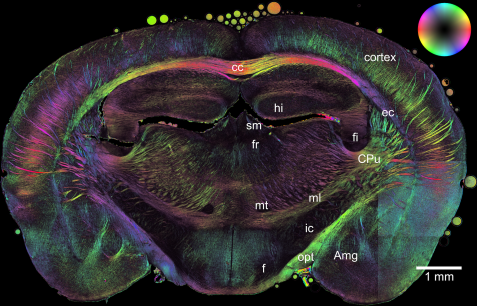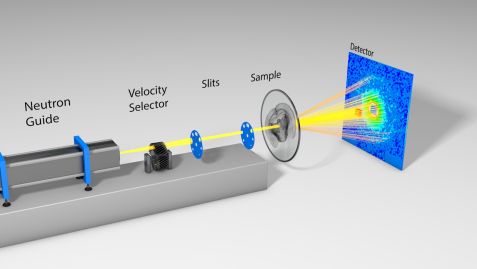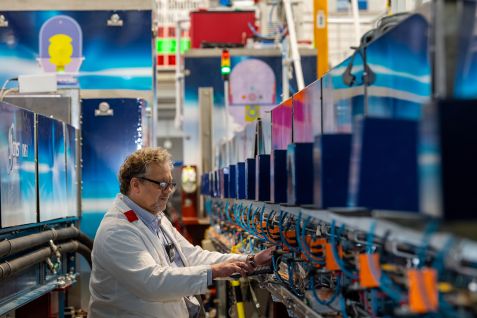MLZ is a cooperation between:
 > Technische Universität München
> Technische Universität München > Helmholtz-Zentrum Hereon
> Helmholtz-Zentrum Hereon
 > Forschungszentrum Jülich
> Forschungszentrum Jülich
MLZ is a member of:
 > LENS
> LENS > ERF-AISBL
> ERF-AISBL
MLZ on social media:

MLZ (eng)
Lichtenbergstr.1
85748 Garching
17.02.2022
A better understanding of multiple sclerosis

3D Polarized Light Imaging scan of a mouse brain. The structural information about the orientation of the nerve fibers from this image served as a comparison for the new neutron measurements. © Forschungszentrum Jülich
The brain is the center of our nervous system – structural changes are often involved in neurological diseases and mental disorders. A team from Forschungszentrum Jülich has now developed a neutron-based method at the Heinz Maier-Leibnitz Zentrum (MLZ) to examine brain slices and better understand these types of diseases.
The brain can be divided into so-called grey matter and white matter. The white matter contains the axons that transmit stimuli. For faster stimulus transmission, the axons are wrapped in an insulating layer of myelin, similar to a cable where the rubber insulation ensures that no electricity is lost along the way.
Injury or loss of the myelin sheath leads to impaired brain and body functions. In multiple sclerosis, for example, the insulating myelin layer is severely attacked. However, the exact causes of the disease are still unclear.
Researchers at Forschungszentrum Jülich have developed a new imaging method at the small-angle scattering facility KWS-1 at the MLZ to map the density, structure and spatial orientation of nerve fibers and myelin.

Scheme of the experimental setup at the small-angle scattering instrument. The neutron beam hits a brain section ("sample"). A detector records the scattering. © Forschungszentrum Jülich
New method complements previous procedures
“We have been examining brain sections with light microscopy and polarization for a long time,” explains Dr. Heinrich Frielinghaus, head of the KWS-1 group, “but with light you couldn’t be quite sure whether what you were seeing was really the axons.” With the help of neutrons, the researchers can resolve this uncertainty.
The special feature of this new method is that it allows scientists to image the axons bundled into nerve fibers at the same time as the insulating myelin sheath.
“With our neutron-based method, we can confirm the results of previous methods and provide additional information,” says Frielinghaus.
Application in medicine
“Since we work with brain slices, it is of course not a diagnostic procedure,” explains Frielinghaus. From their new method, the researchers hope to better understand the causes of neurological diseases in the future by being able to visualize structural changes in the brain more completely.
The resolution of the new method is still in the millimeter range. However, Frielinghaus and his colleagues expect that micrometer-precision measurements will be possible in the future. This will enable them to examine even the smallest structures in biological tissues.
Original publication:
S. Maiti, H. Frielinghaus, D. Gräßel, M. Dulle, M. Axer, S. Förster, Distribution and orientation
of nerve fibers and myelin assembly in a brain section retrieved by small‐angle neutron scattering, Sci Rep 11 (2021) DOI: 10.1038/s41598-021-92995-2
MLZ is a cooperation between:
 > Technische Universität München
> Technische Universität München > Helmholtz-Zentrum Hereon
> Helmholtz-Zentrum Hereon
 > Forschungszentrum Jülich
> Forschungszentrum Jülich
MLZ is a member of:
 > LENS
> LENS > ERF-AISBL
> ERF-AISBL
MLZ on social media:



